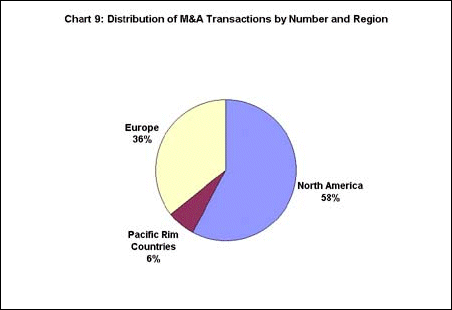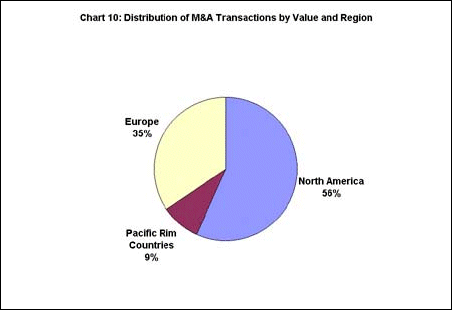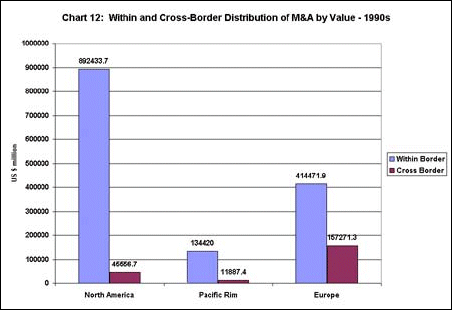|
Needless to
say, in terms of region North America, especially the
US, which has become the apex of financial dominance,
accounted for a overwhelming share of M&A activity
in the study countries in terms of both numbers and
value (Charts 9 and 10). Europe was a close second.
And given the much larger and more dispersed financial
sector in the US, as well the compulsions generated
by monetary union in Europe, M&A activity in North
America was dominated by intra-country, 'within-border'
transactions, whereas cross-border M&A played a
much more important role in Europe (Charts 11 and 12).
But as the report notes, through strategic alliances
the American financial industry has also spread its
tentacles across the globe. In the net, the 1990s have
seen an acceleration of the concentration of financial
power and financial decision-making in fewer hands worldwide.

Chart
9 >> Click
to Enlarge

Chart
10 >> Click
to Enlarge

Chart
11 >> Click
to Enlarge

Chart
12 >> Click
to Enlarge
The significance of these developments
for the observed financial instability and recurrence
of financial crises during the years of globalisation
should be obvious. The major historical landmarks in
the rise to dominance of finance are worth recalling.
Till the early 1970s the private international financial
system played only a limited role in recycling financial
surpluses to the developing countries. The period immediately
after the first oil shock saw a dramatic change in this
scenario. Since oil surpluses were held in the main
as deposits with the international banking system controlled
in the developed world, the private financial system
there became the powerful agent for recycling surpluses.
This power was indeed immense. Expenditure fuelled by
credit in the developed and developing world generated
surpluses with the oil producers, who then deposited
these surpluses with the transnational banks, who, in
turn, could offer further doses of credit. By 1981,
OPEC countries are estimated to have accumulated surpluses
to the tune of $475 billion, $400 billion of which was
parked in the developed industrial nations. This power
to the finance elbow was all the more significant because
a slow down in productivity growth in metropolitan industry
had already been bringing the post-War industrial boom
to a close - a process that was hastened by the contractionary
response to the oil shocks. As a proportion of world
output, net international bank loans rose from 0.7 per
cent in 1964 to 8.0 per cent in 1980 and 16.3 per cent
in 1991. Relative to world trade, net international
bank loans rose from 7.5 per cent in 1964 to 42.6 per
cent in 1980 and 104.6 per cent in 1991.
Two
other developments contributed to the increase in international
liquidity during the 1980s. First, the United States
had built up large international liabilities during
the Bretton Woods years, when the confidence in the
dollar stemming from the immediate post-War hegemony
of the US made it as good as gold. Such international
confidence in its currency allowed the US to ignore
national budget constraints on its international spending
and resulted in the emergence of strong banking and
financial interests with an international agenda. The
influence of these interests was reflected in policies
that affected domestic manufacturing interests adversely,
as suggested by the widening and persistent US trade
deficit after the mid-1970s. Second, the loss of manufacturing
competitiveness in the US meant that during different
periods since the 1970s the dollar lost its position
as the only acceptable reserve currency, fuelling speculative
demand for other currencies on the part of those holding
them. Such speculative demand, needless to say, is sensitive
to both interest rate differentials and exchange rate
variations, resulting in volatile flows of capital across
currencies and borders. The results of these developments
are obvious. The daily volume of foreign exchange transactions
in international financial markets rose to $1.2 trillion
per day by the mid-1990s, which was equal to the value
of world trade in every quarter of a full year. In the
early 1980s the volume of transactions of bonds and
securities between domestic and foreign residents accounted
for about 10 per cent of GDP in the US, Germany and
Japan. By 1993 the figure had risen to 135 per cent
for the US, 170 per cent for Germany and 80 per cent
for Japan. Much of these transactions were of bonds
of relatively short maturities.
There were also other real factors
that created pressures for the expansion of finance.
These included the changing demographic structure in
most of the advanced countries, with baby boomers reaching
the age when they would emphasise personal savings for
retirement. This was accentuated by changes in the institutional
structures relating to pensions, whereby in most industrial
countries, public and private employers tended to fund
less of the planned income after retirement, requiring
more savings input from employees themselves. All this
meant growing demands for more variety in savings instruments
as well as higher returns, leading to the greater significance
of pensions funds, mutual funds and the like.
|

